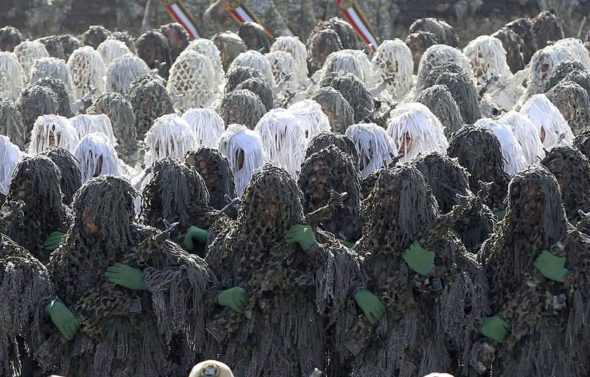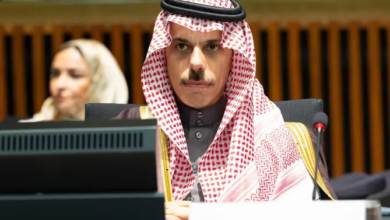
The latest political earthquake in Saudi Arabia has led to much speculation over the future of the kingdom and the Gulf Arab states. But most analyses have ignored the far bigger issue looming over the region’s upheavals: Prospects for a military confrontation between the U.S. and Iran are rapidly escalating.
The Trump administration’s desire to isolate and pressure Iran reflects outdated thinking that does not take into account the shifting realities of today’s Middle East. The most likely outcome is it will inadvertently strengthen Iran’s hand in the region, much as President George W. Bush administration’s invasion of Iraq did in 2003.
Iran is now, arguably, the most powerful regional actor in the Middle East. Tehran is a decisive player in Syria, Lebanon and Iraq, and its influence extends to Yemen and Afghanistan. Pushing back on Iranian power would mean confronting Iranian forces in countries where they are embedded with local militias or have been invited by host governments, as is the case in Iraq and Syria.
Furthermore, Iran is no longer a global pariah. It has a strong partnership with Russia in Syria and increasingly shared interest with Turkey on issues relating to Kurdish independence and strengthening the central government in Baghdad. Both Turkey and Iran back Qatar in its dispute with Saudi Arabia and the United Arab Emirates. That quarrel has created openings for Iran to project itself as a stabilizing force in the Middle East to other major powers such as China and India.
With the Arab world and the Gulf Cooperation Council deeply divided, Washington’s attempts to isolate Iran run counter to European, Russian, and Chinese attempts to cajole Tehran to play a more constructive regional role, one befitting its status as a rising power.
U.S. attempts to undermine the nuclear deal will likely only draw other global actors to Iran’s side, especially as European countries could view Tehran as a more responsible partner in upholding commitments, in contrast to Washington’s new unpredictability.
Iran is also increasingly turning to Asia as a source of credit and commerce. China views Iran as a critical component of its One Belt One Road economic initiative, which seeks to connect Beijing to the Middle East and Europe. Japan, South Korea and India also see Tehran as an untapped market worthy of short-term risks in exchange for future economic gain. All are now buyers of Iranian crude and petrochemicals, and all are looking to make substantial investments in the Iranian economy.
U.S. sanctions against Iran are unlikely to reverse its influence in the Middle East. The Syrian government is heavily dependent on Iran while the Iraqi government views it as a partner in combatting Sunni Jihadism and Kurdish separatism. Sanctions will undoubtedly slow Iran’s economic growth, as they have for the past 40 years, but they will not fundamentally alter Iran’s ability to project influence.
It’s unlikely that the U.S. and Iran will stop antagonizing each other any time soon. But the Trump administration could treat Iran not as a rogue threat but as it would treat any major rival, such as Russia or China. Where suitable Washington could engage with Tehran. When otherwise necessary, it could make clear that it will not compromise on the security and stability of its allies.
Washington and Tehran need to come to an understanding so as not to further enflame the region. This would entail the Trump administration abandoning its attempts to undermine the nuclear agreement and calling for regime change in Iran. Continuing to demonize Iran for all the ills of the Middle East is counterproductive and will only lead to further escalation. This strategy was employed during the George W. Bush administration with disastrous consequences.
The Trump administration should re-establish high level contact that existed during the previous administration and broaden the scope of diplomatic engagement to include regional security issues. The should take place at the ministerial level, with Foreign Minister Javad Zarif and Secretary of State Rex Tillerson. If nothing else, this would ease some tension and provide a pressure valve for airing grievances.
It can also resolve crises that may arise in the Persian Gulf, where both navies operate. In 2016, Iran’s capture of U.S. sailors was resolved peacefully because of the rapport established between Secretary of State Kerry and Foreign Minister Zarif. It is difficult to imagine in today’s contentious climate such an incident settled without a shot being fired. Diplomatic channels to deconflict between hostile countries are necessary.
It is unlikely that the U.S. could dissuade Iran from some of its most troublesome activities such as supporting Hezbollah or Hamas, but there is a middle ground in which the two sides can live with the existing realities on the ground. For example, the U.S. and Iran have a shared interest in preventing the reemergence of the Islamic State in Syria and Iraq. Neither side wants the political uncertainty in Lebanon (now imminent because of Harriri’s resignation) to spiral out of control. Both Tehran and Washington want to strengthen the central government in Afghanistan. Ultimately, both countries have a vested interest in seeing the sectarian violence that has engulfed the region come to an end.
U.S. policymakers should not assume they can reverse the trends of the last 15 years. The U.S. invasion of Iraq showed how poor planning and erroneous assumptions can backfire. At the time, the Bush administration wrongly predicted that liberating Iraq from Saddam Hussein would unleash democratic movements across the region and diminish Iranian influence. Similarly, possibly faulty assumptions when it comes to Iran could pave the way for the permanent erosion of American power in an increasingly unpredictable Middle East.
This column does not necessarily reflect the opinion of the editorial board or Bloomberg LP and its owners.




